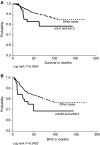Expression and co-expression of the members of the epidermal growth factor receptor (EGFR) family in invasive breast carcinoma
- PMID: 15480434
- PMCID: PMC2410019
- DOI: 10.1038/sj.bjc.6602184
Expression and co-expression of the members of the epidermal growth factor receptor (EGFR) family in invasive breast carcinoma
Abstract
The epidermal growth factor receptor (EGFR) family plays an important role in breast carcinogenesis. Much interest has been focused recently on its members because of their potential role as prognostic indicators in breast cancer and their involvement in cancer therapy. We have evaluated more than 1500 cases of invasive breast carcinoma immunohistochemically using tissue microarray technology to examine the expression of EGFR family receptor proteins. We have found that 20.1 and 31.8% of cases were positive for EGFR and c-erbB-2, respectively, and 45 and 45.1% of tumours overexpressed for c-erbB-3 and c-erbB-4, respectively. The expression of either EGFR or c-erbB-2 was associated with other bad prognostic features and with poor outcome. Neither c-erbB-3 nor c-erbB-4 had any association with survival. c-erbB-2 had an independent prognostic effect on overall and disease-free survival (DFS) in all cases, as well as in the subset of breast carcinoma patients with nodal metastases. Several hetero- and homodimeric combinations have been reported between the EGFR members. Those dimers can evoke diverse signal transduction pathways with variable cellular responses. We stratified cases according to their co-expression of receptors into distinct groups with different receptor-positive combinations. Patients whose tumours co-expressed c-erbB-2 and c-erbB-3, as well as those whose tumours co-expressed EGFR, c-erbB-2 and c-erbB-4 showed an unfavourable outcome compared with other groups, while combined c-erbB-3 and c-erbB-4 expression was associated with a better outcome. In cases showing expression of one family member only (homodimers), we found a significant association between c-erbB-4 homodimer-expressing tumours and better DFS. In contrast, patients with c-erbB-2 homodimer-expressing tumours had a significant poorer DFS compared with other cases. These data imply that the combined profile expression patterns of the four receptor family members together provide more accurate information on the tumour behaviour than studying the expression of each receptor individually.
Figures








References
-
- Alimandi M, Romano A, Curia MC, Muraro R, Fedi P, Aaronson SA, Di Fiore PP, Kraus MH (1995) Cooperative signaling of ErbB3 and ErbB2 in neoplastic transformation and human mammary carcinomas. Oncogene 10: 1813–1821 - PubMed
-
- Brandt BH, Roetger A, Dittmar T, Nikolai G, Seeling M, Merschjann A, Nofer JR, Dehmer-Moller G, Junker R, Assmann G, Zaenker KS (1999) c-erbB-2/EGFR as dominant heterodimerization partners determine a motogenic phenotype in human breast cancer cells. FASEB J 13: 1939–1949 - PubMed
-
- Brennan PJ, Kumagai T, Berezov A, Murali R, Greene MI, Kumogai T (2000) HER2/neu: mechanisms of dimerization/oligomerization. Oncogene 19: 6093–6101 - PubMed
-
- Camp RL, Charette LA, Rimm DL (2000) Validation of tissue microarray technology in breast carcinoma. Lab Invest 80: 1943–1949 - PubMed
MeSH terms
Substances
LinkOut - more resources
Full Text Sources
Other Literature Sources
Medical
Research Materials
Miscellaneous

